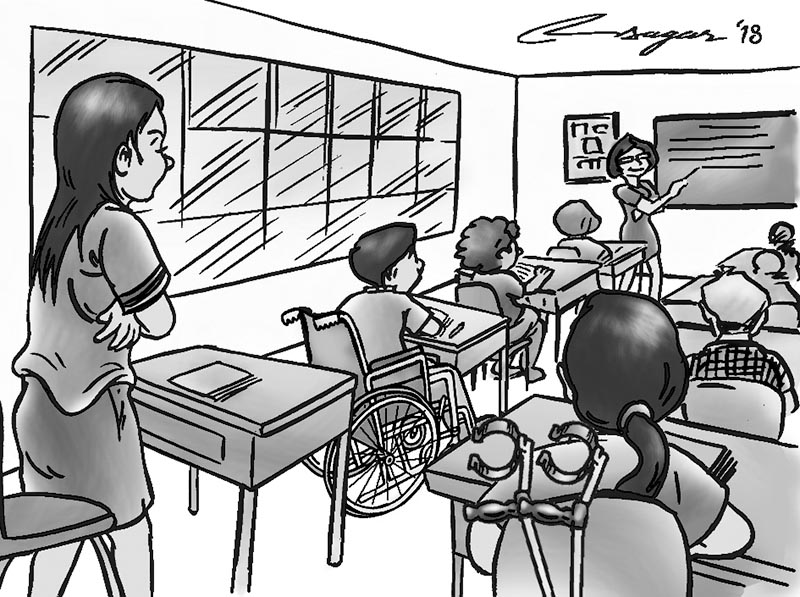Inclusive education: A tool for social change
The SDG will cover the period from 2015-2030. Nepal has further committed to SDG4 to ‘ensure equal access to all levels of education and vocational training for the vulnerable, including persons with disabilities’ by 2030
Each individual should have an equal opportunity for educational progress. Education is a key issue. On top of that, inclusive education is a pre-requisite for the accomplishment of all other rights.
Inclusive education is about how we develop and design our schools, classrooms, programmes and activities so that all students can learn and participate together. Inclusive education system provides a better-quality education for all children and is instrumental in creating more inclusive and open societies. Schools provide the context for a child’s first relationship with the world outside their families, enabling the development of social relationships and interactions.
But realisation of the right to education still is a pipedream for girls with disabilities, especially in remote rural areas as they face multiple challenges. These problems are associated to disability-related discrimination. What is worrying is some of the challenges they have to face only because of the fact that they are girls.
Some parents do not send girls with severe disabilities to schools in order to protect them from the stigma associated with education.
In some rural areas of Nepal, girls during their menstruation are kept in an isolated sheds as it is feared that if a menstruating girl touches a man or a plant or even an animal, some bad omen befalls the family or the village. Despite a new law criminalising the age-old practice of banishing menstruating girls from home, the scourge continues.
Additional hurdles include distance to school, inaccessible physical environment and physical and verbal abuse girls with disabilities face. Girls with physical disabilities and visual impairment fail to attend and repeat classes due to difficulties in walking to school. Similarly, girls with hearing impairments fail to participate in classroom activities.
Additionally, girls with disabilities are troubled with domestic tasks due to their gender. Boys with disabilities on the other hand are exempt from this predicament. Paternalistic tendencies affect the positive realisation of the right to education for girls with disabilities.
Moreover, the prevalent cultural attitudes and practices at homes, schools and communities hinder the realisation of the right to education for girls with disabilities.
Article 26 of the Universal Declaration on Human Rights (UDHR) provides for compulsory and free elementary education. It also states that education is aimed at full development of the person.
Then, the International Covenant on Economic, Social and Cultural Rights (ICESCR) articulated the right to education in Articles 13 and 14.
States parties under the Convention on the Elimination of All Forms of Discrimination against Women (CEDAW) are obliged to take appropriate measures to eliminate discrimination against women in the realisation of right to education.
Article 23 of the Convention on the Rights of the Child (CRC) states that a disabled person has the right to special care, education and training to help him or her to enjoy a full and decent life and achieve the greatest degree of self- reliance and social integration possible.
Article 24 of the United Nations Convention on the Rights of Persons with Disabilities (UNCRPD) lays down several obligations for state parties. Firstly, it calls for ensuring legislation to promote the right to education for persons with disabilities of all ages and providing equal educational opportunities at all levels of education.
Secondly, state parties are obliged to advance inclusive education systems that allow children with disabilities to learn alongside their peers in inclusive schools. State parties are also obliged to ensure that the education of blind, deaf or deaf-blind children is delivered in most appropriate models and environments.
Third, state parties should adopt specific measures to ensure that persons with disabilities are not excluded from the general education system or from free and compulsory primary education.
Fourth, state parties’ legislation should provide for persons with disabilities benefits from reasonable accommodation to facilitate their ability to learn in general educational settings. They should also receive the support required to facilitate their effective education including effective individualised support measures.
Fifth, state parties should employ teachers who are qualified to teach children with disabilities.
Quality inclusive education is a fundamental part of the new Sustainable Development Goal (SDG) agenda, which has succeeded the UN’s Millennium Development Goals (MDGs).
The SDG will cover the period from 2015-2030. Nepal has further committed to SDG4 to “ensure equal access to all levels of education and vocational training for the vulnerable, including persons with disabilities” by 2030.
In conclusion, girls living in rural areas in developing nations like Nepal face various forms of discrimination due to their age, sex and disability.
Consequently, these increase the practical challenges which they face to realise the right to education.
States have obligations to respect, protect and fulfil the availability, accessibility and adaptability of the right to education.
Joshi is disability rights lawyer






